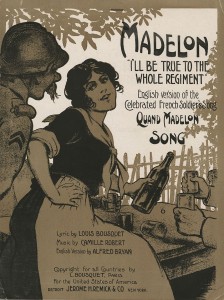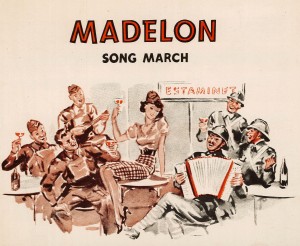Lost in translation? Madelon and “Somewhere in France”
For the “Somewhere in France” exhibition, which opened in the Baillieu Library’s Noel Shaw Gallery earlier this month, the Rare Music Collection was delighted to contribute several items for display: print music and programs for concerts held to raise money to assist Belgium and France. Featuring bright colours drawn from the national flags of France and Belgium, the framed covers make a striking display.
The one exception, with its shades of brown and black, is the cover of the sheet music to Madelon (known as Quand Madelon in the original French version of 1914), a march song that was to become one of the most popular for French and English-speaking soldiers fighting in France from 1916. It was also a hit in the music halls of Paris from 1917.[1] The music is by Camille Robert, with original lyrics by Louis Bousquet.

The lyrics of the English-language version of Madelon on display tell, in two verses and chorus, of a pretty young waitress in her father’s country tavern. Soldiers of various ranks flirt with her, but Madelon treats them all with grace and good humour as she works, serving their drinks, favouring none over the other. The song is skilfully encapsulated by French illustrator Clérice in the cover image. It shows a woman with wine bottle poised to fill empty glasses held out to her by men unseen. Only her head is inclined towards a French soldier with a pronounced moustache—probably a corporal—who leans in very close to her. Her posture and expression may be read as mildly flirtatious, but she continues with her task.
Click below to listen to a recording of this version of Madelon, made late last year, with the English-language lyrics by Alfred Bryan interpreted by Kiran Rajasingam (baritone) and Amir Farid (piano). Sung at a slower tempo than many French-language recordings of Madelon, here the lyrics can be heard with great clarity.
Madelon recording (English-language version, 1918)
The original French words, however, are different, with an extra verse and other layers of meaning. The last lines of the original verse one translates as “She’s only Madelon but, for us, she’s love [or romance]” and a middle verse opens with the lines “Well every soldier has at home his dearest / the girl who waits and one day will be his” and ends with “We laugh and think of her who’s waiting over there”.[2] These sentiments, omitted from the version in the recording, shift the soldier’s romantic focus away from Madelon herself to what she represents and appeal instead to a soldier’s desire to return home to romance and domesticity.
In his book The French in Love and War, Charles Rearick reads Madelon as an “old fashioned woman”. He suggests that to rank and file French soldiers, the character of Madelon was “comfortable and cheering” as she served men in a traditional manner, unlike the “new woman” who relished the opportunity of jobs formerly restricted to men: in the métro or munitions factories, for instance. For civilians in the audience in the Paris music halls of 1917, where the song “took off”, Rearick believes the appeal lay also in the evocation of the soldier as playful, innocent and leisured, rather than as “war-sick mutineer [or] … sexual predator”. For soldier and civilian alike there was, by then, a relief that the song itself makes no direct reference to war.[3]
Many songs popular in World War I resurfaced when war returned and Madelon was no exception. Rare Music has a second English language version, copyrighted in 1939, that is different in many ways. The march rhythm is no longer notated within a time signature of 2/4 but a more lilting 6/8; and chord charts are supplied for the ukulele, an instrument also depicted on the cover.

Cover (detail) of “Madelon” (J.R. Lafleur & Son, 1939)
The “meta” quality of the lyrics is striking: while the French lyrics are reproduced unchanged from the American edition of 1918, when sung in English, the song is about Madelon, the song.[4]
They used to sing a good old chorus,
They learnt the words “somewhere in France” […]
The song is “MADELON”, we sang it with a will,
Now history repeats itself, we sing it still.
And the cover could scarcely be more different only 25 years on. Gone is the traditionally dressed rural woman attending to her duties in spite of male attention. Here Madelon, decidedly “fashion forward”, and sporting a borrowed army cap, sits on a table surrounded by soldiers and raises her wine glass with them.
Jennifer Hill, Curator, Music
[1] Charles Rearick, The French in love and war: popular culture in the era of the two World Wars, 1914–1945 (Yale University Press, 1997), 3, 18–19 and 27.
[2] Translation based on Frances C. Fay’s “faithful” singing translation of the original French lyrics reproduced in “The songs the soldiers sing”, World’s News (Sydney), 30 November 1918: 4.
[3] Rearick, 25–29.
[4] The new lyrics are by British writer and broadcaster Ray Sonin.
Categories
To Archives and Special Collections and Ms. Hill:
I came across this informative blog entry when researching my own blogpost on La Madelon, which you may read here: https://www.beeretseq.com/a-case-of-champlain/
My context was quite different, but I thought still you might like to read it.
(I write on many aspects of world brewing history, based at my blog shown).
Best regards.
Gary Gillman, Toronto
Thank you, Gary, for getting in touch and sending a link to your blog. Fascinating to read of Champlain’s La Madelon beer and what Madelon signified in mid-1930s French Canada. Jen Hill